
Bella consults is a blog which purports to be “musings of the office dog at Bissantz” which I blogged earlier on the subject. So far (as of Friday, Dec. 15th) it is a great summary of what to do and not do with sparklines.
Bella is a Labrador that appears at different ages in a composite picture that Edward Tufte reproduces in Beautiful Evidence (page 43.) Tufte reproduces the image to show how one can create visualizations that combine multiple images where the “measurement labels are place directly in the photograph where they belong” instead of forcing the reader to decode labels. Tufte says everyone should use “Bella reporting standards”. Bella’s blog is presumably a meditation on her standards.
Thanks to Roland Zimmermann for pointing this out to me and also pointing me to his short essays Bissantz ponders.
 We are adding
We are adding 
